On May 27, 1958, the XF4H-1 prototype of what would become the legendary McDonnell Douglas F-4 Phantom II, made its first flight at the controls of test pilot Robert "Bob" Little, taking off from the runway annexed to the factories of the McDonnell Aircraft Corporation of St Louis, Missouri. Although more than 62 years have passed since then, the long flight of the McDonnell Douglas F-4 Phantom II has not yet ended and indeed, the last F-4 still in service in the world continue to be talked about as the profound programs of updates to which they have been and continue to be subjected have ensured that the mighty twin-engine of American origin still continues to be performing and in step with the times.
Although the F-4 is most associated with the air battles and tactical support actions that took place under the American and Israeli ensigns over the skies of Indochina and the Middle East, too many forget that there were 12 countries in all that deployed the "Beater of St Louis" with its own air force, very often in large numbers and for very long periods of time. An important example, from this point of view, is Japan. The land of the Rising Sun was in fact for 48 years one of the most important users of the Phantom, and it is not certain that the history of the F-4 under the rosettes of the samurai country cannot reserve unexpected last minute surprises; but let's proceed in order.
Japan chose the McDonnell Douglas F-4 Phantom II as a tactical heavy fighter in the late 60s to completely overhaul its first line of combat and reconnaissance, at that time based on: 122 North American F-86D "Gekko", 435 North American F-86F "Kyokko", 18 North American RF-86F, 210 Lockheed F-104J "Eiko" and 20 Lockheed F-104DJ "Eiko", supported by no less than 287 Lockheed T-33 "Wakataka" armed trainers .
 Despite having a theoretical line of nearly 1.100 aircraft at their disposal, the Japanese political and military leaders knew very well that this apparently powerful deployment was by no means sufficient to meet the security requirements of their country. First of all, the line of trainers was rapidly experiencing rapid and inexorable obsolescence. Secondly, the Japanese fighter aircraft were totally devoid of any air-to-ground capability and were unable to support the ground forces should they find themselves in the situation of facing a Soviet invasion. Finally, the introduction during the 50s and 60s, followed by a whole series of "second and third generation" Soviet jets such as the Mikoyan-Gurevich Mig-17 "Fresco", the Mikoyan-Gurevich Mig -19 "Farmer", the Mikoyan-Gurevich Mig-21 "Fishbed" (photo), the Mikoyan-Gurevich Mig-23 "Flogger" and the Mikoyan-Gurevich Mig-25 "Foxbat" as well as the Chinese Shenyang J-5 / F-5 "Fresco", Shenyang J-6 / F-6 "Farmer" and Chegdu J-7 / F-7 "Fishcan / Airguard" (the Chinese aircraft in turn derived respectively from the Mig-17, from the Mig-19 and from the Mig-21) all highly performing both in terms of speed and maneuverability, had made the Japanese fighter array absolutely unable to oppose anything more than a weak resistance against the excessive enemy aircraft power, with the risk that a possible invasion Soviet (at that time by no means to be ruled out!) would only have met with superficial opposition from the "Japanese Self-Defense Forces" (JSDF) before tr wind them up and force Tokyo to capitulate.
Despite having a theoretical line of nearly 1.100 aircraft at their disposal, the Japanese political and military leaders knew very well that this apparently powerful deployment was by no means sufficient to meet the security requirements of their country. First of all, the line of trainers was rapidly experiencing rapid and inexorable obsolescence. Secondly, the Japanese fighter aircraft were totally devoid of any air-to-ground capability and were unable to support the ground forces should they find themselves in the situation of facing a Soviet invasion. Finally, the introduction during the 50s and 60s, followed by a whole series of "second and third generation" Soviet jets such as the Mikoyan-Gurevich Mig-17 "Fresco", the Mikoyan-Gurevich Mig -19 "Farmer", the Mikoyan-Gurevich Mig-21 "Fishbed" (photo), the Mikoyan-Gurevich Mig-23 "Flogger" and the Mikoyan-Gurevich Mig-25 "Foxbat" as well as the Chinese Shenyang J-5 / F-5 "Fresco", Shenyang J-6 / F-6 "Farmer" and Chegdu J-7 / F-7 "Fishcan / Airguard" (the Chinese aircraft in turn derived respectively from the Mig-17, from the Mig-19 and from the Mig-21) all highly performing both in terms of speed and maneuverability, had made the Japanese fighter array absolutely unable to oppose anything more than a weak resistance against the excessive enemy aircraft power, with the risk that a possible invasion Soviet (at that time by no means to be ruled out!) would only have met with superficial opposition from the "Japanese Self-Defense Forces" (JSDF) before tr wind them up and force Tokyo to capitulate.
Although the studies for the development of new high performance and possibly armable training aircraft were at an advanced stage and would soon produce the Fuji T-1 "Hatsutaka", the Mitsubishi T-2 and the Kawasaki T-4, while those for a support fighter with a strong vocation for air-to-ground and naval interdiction missions would have generated the revolutionary Mitsubishi F-1, the pressing problem remained of equipping the "Air Self-Defense Force" (JASDF) with a new heavy fighter that it should have formed the backbone of the hunting parties for at least twenty years.
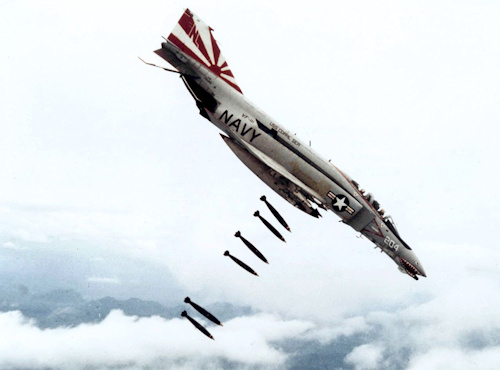 After carefully observing the performance of the air forces of the United States of America during the contemporary "Vietnam War" (photo), the Japanese decided, on November 1, 1968, to finally opt for the "F-4E" and " RF-4E ”of the McDonnell Douglas F-4 Phantom II.
After carefully observing the performance of the air forces of the United States of America during the contemporary "Vietnam War" (photo), the Japanese decided, on November 1, 1968, to finally opt for the "F-4E" and " RF-4E ”of the McDonnell Douglas F-4 Phantom II.
According to the original requirement, the early Japanese F-4Es, renamed "F-4EJs", were optimized for air defense and lacked any ground attack capability, so the system was removed one after another. control for nuclear weapons AN / ASQ-9A, the control system for air-to-surface missiles (ASM) AN / ARW-77 "Bullpup" (essential for the use of air-to-surface missiles with conventional or nuclear warhead AGM-12 “Bullpup”, which in fact were not purchased), the AN / AQS-91 weapon release system, and the AN / AJB-7 bombing system. There was also no equipment for refueling in flight.
Just like the USAF's F-4Es, the JASDF's F-4EJs were equipped with the AN / APQ-120 radar targeting system, the 20mm M61A1 "Vulcan" rotating barrel cannon with 640 bullets and could launch the AIM-9 “Sidewinder” and AIM-7 “Sparrow” air-to-air missiles. As for the navigation systems, both the AN / ASN-63 set and the AN / ASN-46A were retained.
Unlike their American cousins, Japanese jets were equipped with numerous electronic systems of Japanese origin, such as the warning system located in the J / APR-2 queue, plus a domestic-origin data-link system called AN / APR- 670 to interface with the BADGE (Base Air Defense Ground Environment) alert system.
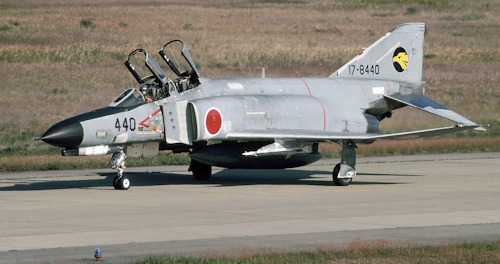
From an aesthetic point of view, the F-4EJs were identical to the USAF's F-4Es except for the stabilizers and wings without extendable slats. A total of 140 F-4EJs were ordered, the first two of which (featuring JASDF serial numbers 17-8301 and 17-8302 respectively) were built by McDonnell Douglas in St Louis and delivered on January 14, 1971, immediately commencing an intense campaign. test at the JASDF. These first two specimens were then followed by 11 others (showing JASDF serial numbers from 27-8303 to 27-8307, from 37-8307 to 37-8310 and from 47-8311 to 47-8313) produced by McDonnell Douglas in the form of kit and then assembled at Mitsubishi Heavy Industries Ltd. with the first specimen (27-8303) which made its first flight as early as May 12, 1972. Then followed the other 127, all built under license by Mitsubishi in the following years until 1981 when, on May 20, 1981, the last specimen was delivered (serial number JADSF 17-8440) which, for a curious game of history, was not only the last F-4 produced for the Japanese armed forces, but was also the last F-4 ever produced in the world (photo).
As already mentioned, the F-4EJs were not originally equipped with the equipment suitable for in-flight refueling missions; nevertheless, these instruments and systems were delivered and stored in the warehouse and, after several years, thanks to the change in the geopolitical and strategic situation in Japan, they were quickly installed on almost all Japanese aircraft. In reality, even after this update, necessary and sacrosanct, given the absence of tankers in service with the Japanese air forces, the F-4EJs were able to demonstrate their added value only during the joint exercises with the United States of America, when they were supported and refueled in flight by USAF KC-135 tankers. This until recent years, when the purchase of 2 Lockheed Martin KC-130, 4 Boeing KC-767 and 3 Boeing KC-46 "Pegasus", all in tanker version, finally allowed Japan to "emancipate" and walk with their own legs.
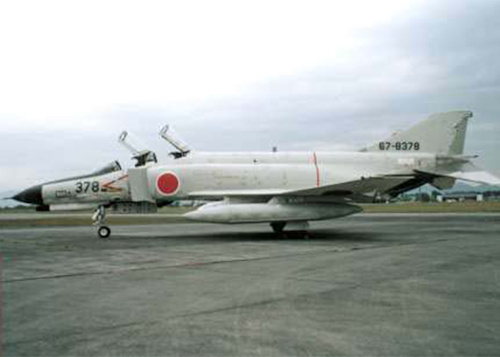
Upon its entry into service, the F-4EJ went to equip 6 air defense units each equipped with a number between 18 and 25 aircraft:
- Give 301 Hiko-tai;
- Give 302 Hiko-tai;
- Give 303 Hiko-tai;
- Give 304 Hiko-tai;
- Give 305 Hiko-tai;
- Come on 306 Hiko-tai.
To strengthen the reconnaissance sector, Japan also ordered 14 examples of the RF-4E reconnaissance version, renamed in Japan "RF-4EJ". Given the small size of the order, all the aforementioned aircraft were produced by McDonnell Douglas and delivered directly to the Japanese Air Force between November 1974 and June 1975 without requiring any licensed production.
At the time of entry into service, the Japanese reconnaissance Phantoms differed from the USAF's RF-4Cs only in the elimination of some US-made electronic equipment, such as the electronic alarm suite and for missile homing, replaced by similar equipment produced in Japan. Furthermore, unlike the reconnaissance Phantoms intended for the American and Israeli air forces, the Japanese reconnaissance aircraft were not configured to carry any type of offensive or defensive weaponry, relying on their survival only on the speed guaranteed by the combination of General Electric J79 engines.
After delivery, all reconnaissance aircraft were assigned to Hyakuri's Dai 501 Hiko-tai. Deeply updated in the early 90s, most RF-4EJs were re-designated RF-4EJ Kai (the suffix “Kai” in Japanese military designations literally means “modifications with update”).

More capable than their predecessors, the RF-4EJ Kai were equipped with the AN / APQ-172 radar and subsequently configured to carry five different reconnaissance sensor attachments. Due to the loss of two specimens belonging to the original lot and to a reduced availability of resources for reconnaissance due to the intense use and wear of the cells, the military leaders and technical offices of the JASDF managed to overcome the problem by converting 17 F- 4EJ to RF-4EJ standard: Delivered in a light seagull gray colouration, then changed to a brown and two-tone green camouflage pattern, these "F-4EJs converted to reconnaissance tasks" featured a very different nose than originally designed aircraft and built as RF-4EJ, also did not undergo structural changes to the cell and retained a limited combat capacity. Although they did not have the possibility to mount internal cameras, these "converted RF-4EJs" could carry different types of reconnaissance pods including the TACER (electronic reconnaissance pod equipped with datalink), the TAC (pod with reconnaissance cameras KS-135A and KS-95B), the infrared detection system D-500UR and the LOROP pod (equipped with KS-146B camera). The original 29 RF-4EJ, RF-4EJ Kai and RF-4EJ "converted" were thus all concentrated in the "Teisatsu Koku-tai" (Tactical Reconnaissance Group) within the Dai 501 Hiko-tai and over the decades have seen extensive use.
It is not entirely clear what kind of missions the Japanese reconnaissance Phantoms have been deployed on, although it is very likely that they have participated in deep reconnaissance missions to Russia, China and North Korea (and possibly even Korea. South and Taiwan), and officially none of them have been lost by the enemy. However, the fact that the Japanese authorities (usually absolutely open and transparent about military information) have always refused to leak any information about their scouts' missions and jobs and that, even 45 years after their arrival in Japan, the identification freshmen of only 11 aircraft are known (against the 31 that at one time or another were part of the "Teisatsu Koku-tai") raises the legitimate suspicion that the Japanese in this case were not of the all transparent.
In 1982, aware of the rapid obsolescence of the original project as well as the appearance of new fearsome Soviet super-fighters such as the Mikoyan-Gurevich Mig-29 "Fulcrum", the Mikoyan-Gurevich Mig-31 "Foxhound" and the Sukhoi Su-27 " Flanker ”, the Japanese high command decided to undertake an in-depth study in order to bring the F-4EJs to a new standard suitable for the 90s and ensure their permanence in service well into the 21st century. By 1984 the study phase was completed and, in 1990, the project became a reality with the introduction into service of the F-4EJ “Kai”.
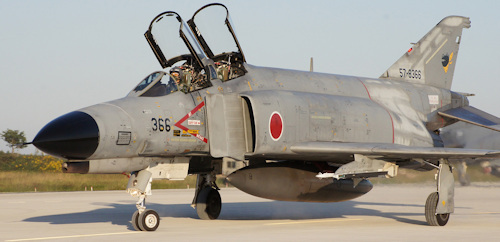
The original program included the updating of 110 aircraft, then reduced to 90 (but according to other sources 86, 91 or 96) and distributed among 3 squadrons (the Dai 301 Hiko-tai, the Dai 302 Hiko-tai and the Dai 306 Hiko -tai) each characterized by a staff of 22 ready-to-use aircraft plus a certain number of reserves. Several specimens of both F-4EJ and F-4EJ Kai were then destined for the Hiko Kaihatsu Jikken-dan (Testing and Development Department) of Gifu, in turn dependent on the Koku Kaihatsu Jikken Shudan (Command for Air Testing and Development) of Hiruma, where the Phantom would have played the role of test worms for the experimentation and introduction of new weapons. Those of the Dai 306 Hiko-tai were later transferred to the Dai 8 Hiko-tai when the first unit was selected for conversion to the F-15Js.
In addition to the extensive avionics upgrades, the "Kai" program also included a thorough structural review (SLEP) in order to extend the fatigue life of the Phantoms in order to extend cell life from 3000 to 5000 flight hours ( this initiative dictated by an urgent operational need, considering that, from 1 May 1973 to 18 October 2017, the JASDF lost a total of about 30 F-4s of all versions in as many plane crashes).
The main changes to the F-4EJ Kai centered on the adoption of the Northrop Grumman (Westinghouse) AN / APG-66J radar based on the technology of that installed on the F-16, in place of the older Westinghouse AN / APQ-120. The new radar, much lighter and smaller, offered considerable improvements in terms of potential and reliability. Other notable changes included: the replacement of the central computer with the digital one of local production J / AYK-1, the INS from the analog AN / ASN-63 INS to the digital J / ASN-4, the RWR from the J / APR -2 to J / APR-6A and other modifications.
A key aspect of the F-4EJ Kai conversion was the upgrade of the RWR system to the J / APR-6A standard with technology based on the J / APR-4 mounted on the F-15J. AN / ALQ-131 electronic deception pods were also installable.
 External additions to the modified "Kai" aircraft included two rearward-facing RWR antennas above the fin, of the same type as those straight forward at the wingtips, a broad blade antenna in the middle of the back of the fuselage, for the new UHF radio, another on the door of the front leg of the truck and a new radome with longitudinal stiffeners.
External additions to the modified "Kai" aircraft included two rearward-facing RWR antennas above the fin, of the same type as those straight forward at the wingtips, a broad blade antenna in the middle of the back of the fuselage, for the new UHF radio, another on the door of the front leg of the truck and a new radome with longitudinal stiffeners.
From the point of view of armament, the F-4EJ Kai continued to have air-to-air capabilities with AIM-9L / P "Sidewinder" and AIM-7E / F "Sparrow" missiles and, starting in 1991, the arsenal of short-range weapons was further strengthened with the adoption of the Mitsubishi AAM-3 missile in combination with or in place of the “Sidewinder”. The adoption of the AN / APG-66J radar also gave the modernized Japanese Phantoms a remarkable capability in the field of search and shooting down (in English "lookdown / shootdown capability") while increasing their BVR ("Beyond- Visual-Range "," Beyond the Visual Range ") which reached their peak with the subsequent integration of the Mitsubishi AAM-4 missiles (both in the original AAM-4 version and in the improved AAM-4B) belonging to the same class of the American AIM-120 AMRAAM, even if they have not found to date the rumors of an integration of the subsequent Mitsubishi AAM-5.
As mentioned above, at the time of their entry into service, the original F-4EJs had been deprived of any air-to-ground capability, leaving this operational niche to be assigned to other types of aircraft. Time and the changing operational contexts have led to reconsider this original decision, and already in the course of the 80s, the F-4EJs were equipped with the nationally produced infrared guidance system GCS-1 for precision attacks allowing Phantom using free-fall bombs Mark 82 (Mk 82) and JM117 (M117).
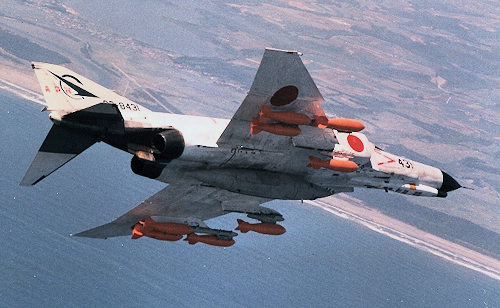
The improvements made to the “Kai” variant not only allowed the F-4s to maintain such capabilities, but further increased their attack effectiveness thanks to the adoption of the ASM-1 and ASM-2 anti-ship missiles. Officially defined as "anti-aircraft landing missiles" (in relation to the purely defensive role of the Japanese armed forces) the ASM-1 and the ASM-2 still represent the most important air-launching anti-ship platforms in the arsenal of the Rising Sun. Of the two, the most advanced is the ASM-2, equipped with an infrared guidance system active in the end of the race and powered by a tiny turbojet manufactured by Nissan Motors.
This "multi-mission" capability and the increase in the service life of the Phantoms through the "Kai" program were necessary among other things to bridge the gap between the withdrawal of the Mitsubishi F-1 attack fighters (which occurred in 2006) and the full entry into service of the new Mitsubishi F-2 multi-role support fighter, the result of the JASDF FS-X program (which caused quite a few headaches). Despite the passing of the decades and the introduction of new and more powerful aircraft such as the Mitsubishi F-15J / DJ (Japanese copy of the American McDonnell Douglas F-15C / D "Eagle") and the Mitsubishi F-2A / B, at beginning of the new millennium the Phantoms still occupied a fundamental place in the deployment of the JASDF divided into no less than five units:
- Dai 8 Hiko-tai: unit equipped with F-4EJ Kai, stationed in Misawa, part of the Dai 3 Koku-dan (3rd Air Wing), and subordinate to the Hokubu Koku Homentai (Northern Air Defense Force);
- Dai 301 Hiko-tai: unit equipped with a mixture of F-4EJ Kai and F-4EJ, stationed in Nyutabaru, part of the Dai 5 Koku-dan (5th Air Wing), and subordinate to the Seibu Koku Homentai (Force of Western Air Defense);
- Dai 302 Hiko-tai: unit equipped with a mixture of F-4EJ Kai and F-4EJ, stationed in Naha, part of the Dai 83 Koku-gun (83 ° Air Group), and subordinate to the Nansei Koku Konsei-dan (South-West Composite Aviation Division);
 - Dai 501 Hiko-tai: unit equipped with a mixture of “original” RF-4EJ, “converted” RF-4EJ Kai and RF-4EJ, stationed in Hyakuri and constituting the Teisatsu Koku-tai (Tactical Reconnaissance Group);
- Dai 501 Hiko-tai: unit equipped with a mixture of “original” RF-4EJ, “converted” RF-4EJ Kai and RF-4EJ, stationed in Hyakuri and constituting the Teisatsu Koku-tai (Tactical Reconnaissance Group);
- several F-4EJ and F-4EJ Kai in service at the Hiko Kaihatsu Jikken-dan (Testing and Development Department) stationed in Gifu, in turn under the control of the Koku Kaihatsu Jikken Shudan (Testing and Air Development Command ) by Hiruma.
Within this deployment, the Dai 8 Hiko-tai stationed in Misawa had support fighter duties, the Dai 301 Hiko-tai and the Dai 302 Hiko-tai based respectively in Nyutabaru and Naha performed defense and air interception tasks. in conjunction with the F-15J / DJs from other departments, the Dai 501 Hiko-tai took care of the reconnaissance while the Hiko Kaihatsu Jikken-dan tested the new upgrades, electronics and weapons to be integrated.
For a long time, Japanese political and military decision makers have questioned the need to find a replacement for the Phantom, but this path has proved neither simple nor fast. Originally, the domestically produced Mitsubishi F-2 was believed to serve as a replacement for both the Mitsubishi F-1 and the McDonnell Douglas F-4 Phantom II, however under test of operational use, the F-2 revealed a costly failure that never met original expectations and indeed forced the JASDF to further extend the F-4's stay in service, constantly updating it, and forcing it to become the F-1's replacement, although it was originally an older project! Negotiations with the US government to reach the sale of a hundred Lockheed Martin F-22 "Raptor" led to nothing due to the refusal of the United States to export this strategic asset, while the subsequent proposals relating to the various Eurofighter EF-2000 "Typhoon ", Boeing F / A-18E / F" Super Hornet ", Boeing F-15SE" Silent Eagle "and Dassault Rafale were rejected one after the other because none of the aforementioned aircraft offered a real improvement over the performance of the F-4EJs Kai modernized.
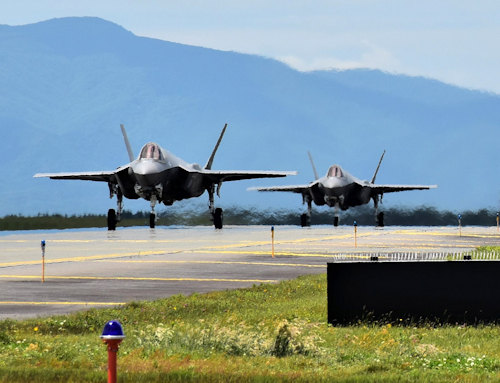 In 2011, after a long period of study, the Japanese political and military leaders announced that the Lockheed Martin F-35 "Lightning II" had finally been chosen to succeed the F-4 which, despite just then celebrating 39 years of service at the JASDF, it was still in service in 90 copies. However, in the following years, things began to evolve very rapidly. The first to suffer the consequences was the Misawa-based Dai 8 Hiko-tai, which was moved to the new Tsuiki base and swapped its F-4EJ Kai for the Mitsubishi F-2, while the Dai 301 Hiko-tai and the Dai 302 Hiko-tai left their Nyutabaru and Naha bases to join the Dai 501 Hiko-tai in Hyakuri, now informally renamed by the Japanese F-4 pilot community: "The Sanctuary".
In 2011, after a long period of study, the Japanese political and military leaders announced that the Lockheed Martin F-35 "Lightning II" had finally been chosen to succeed the F-4 which, despite just then celebrating 39 years of service at the JASDF, it was still in service in 90 copies. However, in the following years, things began to evolve very rapidly. The first to suffer the consequences was the Misawa-based Dai 8 Hiko-tai, which was moved to the new Tsuiki base and swapped its F-4EJ Kai for the Mitsubishi F-2, while the Dai 301 Hiko-tai and the Dai 302 Hiko-tai left their Nyutabaru and Naha bases to join the Dai 501 Hiko-tai in Hyakuri, now informally renamed by the Japanese F-4 pilot community: "The Sanctuary".
Assigned now to the task of providing for the air defense of the capital, the Phantoms continued to fly albeit in gradually smaller ranks, while the older aircraft were progressively grounded.
In March 2019, the F-4s of the Dai 302 Hiko-tai were definitively grounded and, at the same time, the unit was transferred to Misawa in preparation for the transition to the F-35s. On March 9, 2020, the Dai 501 Hiko-tai reconnaissance Phantoms took off for their last flight, after which, with a farewell ceremony, the department itself was dissolved and removed from the JASDF combat order, its functions transferred to a new UAV department equipped with RQ-4 Global Hawk which will be officially declared operational in Misawa in the course of 2021. As for the Dai 301 Hiko-tai, although the original plans provided that the department would continue to lend service with its Phantoms until the end of 2021, budgetary issues due to the Covid-19 crisis finally led to an early interruption of training activities, which took place on November 20, 2020 with a final flight, by a trio of aircraft, broadcast live on all the TVs in the country to close an enviable career lasting 48 years during which the 154 McDonnell Douglas F-4 Phantom II Japanese amassed notless than half a million flight hours to their credit.
 With the deactivation of all front-line departments, the last Japanese F-4s still flying are a handful of specimens still used by the Hiko Kaihatsu Jikken-dan (Testing and Development Department) stationed in Gifu for which it is not a date for the withdrawal has still been made official. However, a more careful observation of events and the geopolitical and military context of the area should lead us to be more cautious about saying that the F-4's career in the Japanese air force is over. In fact, from a geopolitical point of view, the Far East region is one of the hottest in the world and is also characterized by a dangerous overlap of national interests that involve almost all the great world powers.
With the deactivation of all front-line departments, the last Japanese F-4s still flying are a handful of specimens still used by the Hiko Kaihatsu Jikken-dan (Testing and Development Department) stationed in Gifu for which it is not a date for the withdrawal has still been made official. However, a more careful observation of events and the geopolitical and military context of the area should lead us to be more cautious about saying that the F-4's career in the Japanese air force is over. In fact, from a geopolitical point of view, the Far East region is one of the hottest in the world and is also characterized by a dangerous overlap of national interests that involve almost all the great world powers.
Russia, North Korea and, most importantly, the People's Republic of China are countries considered by Japan to be openly hostile, and the possibility that in the near future the Land of the Rising Sun may become embroiled in a large-scale conventional war with one or even all three of these actors simultaneously is never too far from the minds of Tokyo's strategic planners. As if that weren't enough, Japan has very conflicting relations (and real territorial disputes) even with South Korea and Taiwan so that, if for one reason or another, the geopolitical order forged by the Americans in Asia after the World War II should collapse, Tokyo would find itself with 5 hostile states (all first-rate military powers) near its maritime borders.
This and other reasons have prompted the Japanese security leaders to adopt a prudent military policy, based on which, even in the presence of a powerful modernization of the arsenals, even the most dated weapon systems can be kept in "standby" in order to be reactivated in case of supreme need.
 In accordance with this doctrine, JASDF has already announced its intention to maintain approximately 110 McDonnel Douglas F-4 Phantom II of all versions (mainly F-4EJ Kai) in covered and pressurized hangars and to subject them to routine periodic maintenance for at least another 10 years so that they can all be called back to service within a 48 hour period if necessary.
In accordance with this doctrine, JASDF has already announced its intention to maintain approximately 110 McDonnel Douglas F-4 Phantom II of all versions (mainly F-4EJ Kai) in covered and pressurized hangars and to subject them to routine periodic maintenance for at least another 10 years so that they can all be called back to service within a 48 hour period if necessary.
Even if, at the moment, their J79 engines have stopped "roaring", closed in the darkness of their hangars, under the watchful eye of the mechanics and soldiers on guard, the F-4s wait in silence like many sleeping samurai sitting next to them to each other and hibernating in a sort of eternal present, aware of the fact that, should the hostile forces that closely hold their country in the near future attack its safety, they will once again fly and their missiles they will dart across the skies again like so many sharp katanas.
Photo: JASDF / US Navy / Rob Schleiffert / MITSUBISHI HEAVY INDUSTRIES












